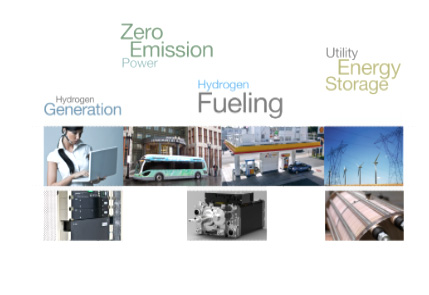Hydrogen is a chemical element with chemical symbol H and atomic number 1. With an atomic weight of 1.00794 u, hydrogen is the lightest element on the periodic table. Its monatomic form (H) is the most abundant chemical substance in the universe, constituting roughly 75% of all baryonic mass.
Hydrogen provides a unique opportunity to reliably generate power with zero on-site emissions of pollutants or greenhouse gases.
Hydrogen releases energy when it bonds with oxygen. Through the use of a Hydrogen Fuel Cell this can be achieved through a reaction of hydrogen by an electrochemical reaction (known as electrolysis) in a fuel cell to produce electricity with the only emission being pure water H2O.

Globally, the use of Hydrogen is involved in many new and innovative projects that stand to change the future of power production for domestic, commercial and industrial applications.
Electrolysers make hydrogen from water, while hydrogen fuel cells use hydrogen to make power.
The H2PowerBox combines these technologies by using solar energy to produce hydrogen through electrolysis, storing it, and then converting it back to electricity with fuel cells, providing clean, reliable power 24/7 in remote and off-grid locations.
Properties of Hydrogen
| Characteristic | Hydrogen | Natural Gas | Gasoline | Hydrogen has... |
|---|---|---|---|---|
| Lower heating value (kJ/g) | 120 | 50 | 44.5 | More energy per kilogram |
| Flammability limits in air (vol%) | 4-74 | 5-15 | 1-7 | Wider flammability limits |
| Density (kg/m³) | 0.082 | 0.67 | 4.4 | More buoyancy |
| Difusion coefficient in air (cm²/s) | 0.61 | 0.16 | 0.05 | Fastest speed |
| Stoichiometric flame speed (m/s) | 2.1 | 0.4 | 0.3 | Fastest burning velocity |
| Minimum ignition energy (mJ) | 0.02 | 0.3 | 0.3 | Easiest ignition |
For information relating to Hydrogen Safety please download the brochure below.
USES OF HYDROGEN IN A RANGE OF INDUSTRIES
Hydrogen powers fuel cell vehicles, supports off-grid energy systems and plays a key role in industrial processes like refining and chemical production. Its versatility makes it an essential part of the shift to clean, sustainable energy.

